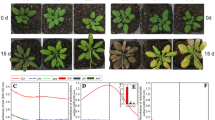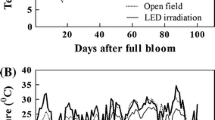Abstract
Similar to many plants, the leaves of Begonia semperflorens accumulate anthocyanins and turn red in autumn. This induction of anthocyanin biosynthesis in autumn has been attributed to low temperature, but the effects of light on this process are still under debate. In the present work, light was found to be necessary for anthocyanin biosynthesis under low temperature. When seedlings were exposed to light and low temperature, both upstream (phenylalanine ammonialyase and chalcone isomerase) and downstream [dihydroflavonol 4-reductase (DFR), flavonoid-3-O-glucosyltransferase (UFGT)] enzymes of the anthocyanin biosynthesis pathway were activated. However, when seedlings were exposed to low temperature in the dark, downstream enzymes (DFR and UFGT) were inhibited. The carbon flux caused by blocked anthocyanin biosynthesis in the dark-exposed plants channeled into flavonoid (for example, flavonol) and phenolic acid, but not lignin, biosynthesis.




Similar content being viewed by others
References
Bruce R, West CA (1989) Elicitation of lignin biosynthesis and isoperoxidase activity by pectic fragments in suspension cultures of castorbean. Plant Physiol 91:889–897
Buysse J, Merckx R (1993) An improved colorimetric method to quantify sugar content of plant-tissue. J Exp Bot 44:1627–1629
Cramer GR, Urano K, Delrot S, Pezzotti M, Shinozak K (2011) Effects of abiotic stress on plants: a systems biology perspective. BMC Plant Biol 11:163
Ellnain-Wojtaszek M, Kruczynski Z, Kasprzak J (2001) Analysis of the content of flavonoids, phenolic acids as well as free radicals from Ginkgo biloba L. leaves during the vegetative cycle. Acta Pol Pharm 58:205–209
Fang F, Huang WD (2013) Salicylic acid modulated flavonol biosynthesis in three key phases during grape berry development. Eur Food Res Technol 237:441–448
Ferrandino A, Lovisolo C (2014) Abiotic stress effects on grapevine (Vitis vinifera L.). Focus on abscisic acid-mediated consequences on secondary metabolism and berry quality. Environ Exp Bot 103:138–147
Griesser M, Hoffmann T, Bellido ML, Rosati C, Fink B, Kurtzer R, Aharoni A, Juan MB, Schwab W (2008) Redirection of flavonoid biosynthesis through the down-regulation of an anthocyanidin glucosyltransferase in ripening strawberry fruit. Plant Physiol 146:1528–1539
He F, Mu L, Yan GL, Pan QH, Wang J, Reeves MJ, Duan CQ (2010) Biosynthesis of anthocyanins and their regulation in colored grapes. Molecules 15:9057–9097
Hughes MH (2011) Winter leaf reddening in ‘evergreen’ species. New Phytol 190:573–581
Iriti M, Faoro F (2009) Bioactivity of grape chemicals for human health. Nat Prod Commun 4:611–634
Juvany M, Muller M, Munne-Bosch S (2012) Leaves of field-grown mastic trees suffer oxidative stress at the two extremes of their lifespan. J Integr Plant Biol 54:584–594
Karageorgou P, Manetas Y (2006) The importance of being red when young: anthocyanins and the protection of young leaves of Quercus coccifera from insect herbivory and excess light. Tree Physiol 26:613–621
Klee HJ (2013) Purple tomatoes: longer lasting, less disease, and better for you. R Curr Biol 23:520–521
Kling B, Bücherl D, Palatzky P, Matysik FM, Decker M, Wegener J, Heilmann J (2014) Flavonoids, flavonoid metabolites, and phenolic acids inhibit oxidative stress in the neuronal cell line HT-22 Monitored by ECIS and MTT assay: a comparative study. J Nat Prod 77:446–454
Krol M, Gray GR, Hurry VM, Oquist G, Malek L, Huner NPA (1995) Low-temperature stress and photoperiod affect an increased tolerance to photoinhibition in Pinus banksiana seedlings. J Can Bot 73:1119–1127
Lacombea A, McGivneyb C, Tadepallia S, Sunc X, Wua VCH (2013) The effect of American cranberry (Vaccinium macrocarpon) constituents on the growth inhibition, membrane integrity, and injury of Escherichia coli O157:H7 and Listeria monocytogenes in comparison to Lactobacillus rhamnosus. Food Microbiol 34:352–359
Li X, Uddin MR, Park WT, Kim YB, Seo JM, Kim SJ, Nou IS, Lee J, Kim HR, Park SU (2014) Accumulation of anthocyanin and related genes expression during the development of cabbage seedlings. Process Biochem 49:1084–1091
Lister CE, Lancaster JE, Walker JRL (1996) Developmental changes in enzymes of flavonoid biosynthesis in the skins of red and green apple cultivars. J Sci Food Agric 71:313–330
Lo SC, Nicholson RL (1998) Reduction of light-induced anthocyanin accumulation in inoculated sorghum mesocotyls. Plant Physiol 116:979–989
McCallum JA, Walker JRL (1990) Phenolic biosynthesis during grain development in wheat: changes in phenylalanine ammonialyase activity and soluble phenolic content. J Cereal Sci 11:35–49
Misyura M, Colasanti J, Rothstein SJ (2013) Physiological and genetic analysis of Arabidopsis thaliana anthocyanin biosynthesis mutants under chronic adverse environmental conditions. J Exp Bot 64:229–240
Mita S, Murano N, Akaike M, Nakamura K (1997) Mutants of Arabidopsis thaliana with pleiotropic effects on the expression of the gene for beta-amylase and on the accumulation of anthocyanin that are inducible by sugars. Plant J 11:841–851
Nakamura N, Fukuchi-Mizutani M, Fukui Y, Ishiguro K, Suzuki K, Suzuki H, Okazaki K, Shibata D, Tanaka Y (2010) Generation of pink flower varieties from blue Torenia hybrida by redirecting the flavonoid biosynthetic pathway from delphinidin to pelargonidin. Plant Biol 27:375–383
Pandey A, Misra P, Bhambhani S, Bhatia C (2014) Expression of Arabidopsis MYB transcription factor, AtMYB111, in tobacco requires light to modulate flavonol content. Sci Rep 4:5018
Peng MS, Hudson D, Schofield A, Tsao R, Yang R, Gu HL, Bi YM, Rothstein SJ (2008) Adaptation of Arabidopsis to nitrogen limitation involves induction of anthocyanin synthesis which is controlled by the NLA gene. J Exp Bot 59:2933–2944
Porter BW, Zhu YJ, Webb DT, Christopher DA (2009) Novel thigmomorphogenetic responses in Carica papaya: touch decreases anthocyanin levels and stimulates petiole cork outgrowths. Ann Bot 103:847–858
Raskin I, Turner IM, Melander WR (1989) Regulation of heat production in the inflorescences of an Arum lily by endogenous salicylic acid. Proc Natl Acad Sci USA 86:2214–2218
Solfanelli C, Poggi A, Loreti E, Alpi A, Perata P (2006) Sucrose-specific induction of the anthocyanin biosynthetic pathway in Arabidopsis. Plant Physiol 140:637–646
Sparvoli F, Martin C, Scienza A, Gavazzi G, Tonelli C (1994) Cloning and molecular analysis of structural genes involved in flavonoid and stilbene biosynthesis in grape (Vitis vinifera L.). Plant Mol Biol 24:743–755
Stafford HA, Lester HH (1984) Flavan-3-ol biosynthesis: the conversion of (+)-dihydroquercetin and flavan-3,4-cis-diol (leucocyanidin) to (+)-catechin by reductases extracted from cell suspension cultures of douglas fir. Plant Physiol 76:184–186
Strazzer P, Guzzo F, Levi M (2011) Correlated accumulation of anthocyanins and rosmarinic acid in mechanically stressed red cell suspensions of basil (Ocimum basilicum). J Plant Physiol 168:288–293
Thwe AA, Kim YB, Li X, Seo JM, Kim SJ, Suzuki T, Chung SO, Park SU (2014) Effects of light-emitting diodes on expression of phenylpropanoid biosynthetic genes and accumulation of phenylpropanoids in Fagopyrum tataricum sprouts. J Agric Food Chem 62:4839–4845
Tokuşoğlu Ö, Ünal MK, Yıldırım Z (2003) HPLC-UV and GC-MS characterization of the flavonol aglycons quercetin, kaempferol, and myricetin in tomato pastes and other tomato-based products. Acta Chromatogr 13:196–207
Zhang KM, Yu HJ, Kai S, Zhou YH, Yu JQ, Xia XJ (2010) Photoprotective roles of anthocyanins in Begonia semperflorens. Plant Sci 179:202–208
Zhang KM, Li Z, Li Y, Li YH, Kong DZ, Wu RH (2013) Carbohydrate accumulation may be the proximate trigger of anthocyanin biosynthesis under autumn conditions in Begonia semperflorens. Plant Biol 15:991–1000
Acknowledgments
This research was supported by the National Natural Science Foundation of China (31101562) and The Key Scientific Research Project of High Education in Henan Province (15A220006).
Author information
Authors and Affiliations
Corresponding author
Rights and permissions
About this article
Cite this article
Zhang, K.M., Guo, M.L., He, D. et al. The Inhibition Effect and Excessive Carbon Flux Resulting from Blocking Anthocyanin Biosynthesis Under Darkness in Begonia semperflorens . J Plant Growth Regul 35, 22–30 (2016). https://doi.org/10.1007/s00344-015-9503-z
Received:
Accepted:
Published:
Issue Date:
DOI: https://doi.org/10.1007/s00344-015-9503-z




